Top Story: Arts
Bogus tickets hit sour note
June 5, 2014
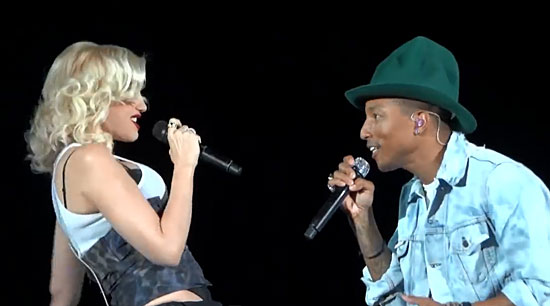
Pharrell Williams, performing before sold-out crowds last weekend, was joined onstage by Gwen Stefani.
Hundreds of Bruno Mars and Pharrell Williams fans found themselves “Locked Out of Heaven” at the Hollywood Bowl last weekend—and they were none too “Happy” about it.
Bowl officials estimate that several hundred would-be concertgoers were turned away from the sold-out shows when their tickets were rejected as counterfeits.
Faux ticket scams are, unfortunately, an increasingly common part of the live concert landscape. Some U2 fans were shut out of the Irish rockers’ Rose Bowl appearance in 2009. Two years ago, a number of Coldplay fans who had paid from $200 for $400 for their tickets found that they too had been duped with bogus tickets to the band’s shows at the Hollywood Bowl.
The profusion of counterfeit tickets this past weekend was widespread enough that, after the first concert on Saturday night, an anonymous Bowl employee was moved to spread the word on Craigslist in a post headlined: “Beware—I saw a lot of fake Bruno Mars tickets.”
“The event has been sold out for a while and tickets range from 200 for nosebleeds to about 1500 for front row,” the warning said, “so if someone is selling good seats for a small amount of money they are probably fake.”
In other words, watch out for deals that seem too good to be true. But be aware that even shelling out a lot for a ticket is no guarantee it’s genuine.
“It’s heartbreaking to have to turn away patrons who we know paid sometimes as much as four times face value for a fraudulent ticket,” says Gail Samuel, chief operating officer for the Los Angeles Philharmonic, which runs the county-owned Bowl under a lease agreement. “When we have a sold-out show like Bruno Mars, there is really nothing we can do to help them.”
With a series of major summer concerts ahead at the Bowl and other venues—including Beyoncé and Jay Z at the Rose Bowl and Paul McCartney at Dodger Stadium—the county Department of Consumer Affairs also has some timely advice for fans.
“A lot of these counterfeit tickets out there look very convincing, so don’t think that you can just look at a ticket and tell whether or not it’s fake,” says Dawnnesha Smith, community outreach manager for the department.
She advises consumers to buy directly from the venue’s box office or its primary ticketer (In the case of the Hollywood Bowl, that’s Ticketmaster.)
It’s best to pay with a credit card, she adds, because those purchases often come with added consumer protections. And “if you see any ads suggesting that you wire someone money to purchase a ticket, that is also a red flag. Once you wire money, it is nearly impossible to get it back so you never want to purchase an item using a wire transfer.”
“It all comes down to buying the ticket from a reputable source,” Smith says, “and being extremely leery of buying tickets online and on classified ad websites such as Craigslist.”
Ticketmaster has some tips of its own, including this one for enthusiastic fans tempted to show off their newly-purchased tickets on Facebook, Instagram and other sites:
“We cannot express this point enough, please do NOT take photos of your ticket stubs and post them on social media sites. This is the perfect way for scalpers to rip these tickets right off you.”
Posted 6/5/14
A new Dawn at the museum
April 16, 2014

After overseeing high-visibility projects all over the county, Dawn McDivitt is ready for a new challenge.
Want to explore the Dawn McDivitt map of Los Angeles?
Here’s an itinerary, just for starters:
A gleaming architectural gem (Disney Hall), an international symbol of great music (the Hollywood Bowl shell), a splashy Civic Center hot spot (Grand Park), a state-of-the-art medical facility (LAC+USC Medical Center), an imposing lockup on the outskirts of downtown (Twin Towers Jail), even a tarry pond right beside Wilshire Boulevard, complete with prehistoric mammoth figures (the La Brea Tar Pits lake bed.)
Over more than two decades, McDivitt has managed projects to build, rebuild or revamp all of those, along with numerous other L.A. County facilities ranging from fire stations to swimming pools. It’s an extensive body of work that has served untold tens of thousands of residents and visitors from every walk of life.
While her pivotal role in bringing all those projects to fruition may be little known to the general public, around the county Hall of Administration, McDivitt is something of a capital projects rock star, with her exuberant laugh, infectious enthusiasm (a favorite adjective: “fabulous!”) and widely-respected ability to get things done.
But, after helping guide the course of more than $2 billion in projects as a manager in the Chief Executive Office, the 56-year-old McDivitt is about to notch a new destination on her professional map: the county’s venerable Natural History Museum.
On May 1, she becomes the museum’s chief deputy director, serving as its No. 2 executive under president and director Jane Pisano.
“She has worked on so many major cultural projects in the county. She really understands and values public-private partnerships and getting things done,” Pisano said. “She is going to be such a great fit here.”
In addition to the main museum in Exposition Park, McDivitt in her new position also will oversee the Page Museum at the La Brea Tar Pits and the William S. Hart Ranch and Museum in Newhall.
“For me, it’s a time for something new, and moving outside of the comfort zone,” McDivitt said on a recent sunny afternoon as she left her 7th floor office to walk through one of her signature accomplishments, Grand Park. “Especially when you stop and realize you’ve been in a place for 20 years.”
The attraction—and the challenge—will be learning to lead a new team in a new environment with a lot of new responsibilities, from human resources to technology, along with more familiar duties like overseeing projects.
“I’m looking forward to learning…I always thrive on knowledge, anyway. I think if you continue to learn, you continue to expand as a person,” McDivitt said. Plus, she added: “I think it’s going to be a really cool environment to work down there because I absolutely love history.”
Like many Angelenos, McDivitt has early memories of going to the Natural History Museum and the Page as a child. And in her professional capacity, she got the chance to oversee a challenging project on the Page/Tar Pits grounds in 2011 when it turned out that the lake was seeping oil and gas into storm drains when it overflowed.
She supervised the CEO’s staff in managing the effort to install a new underground water purification system and connect the tar pits lake to the city sewers beneath Wilshire Boulevard.
Fix-it operations are nothing new to McDivitt.
“It’s kind of like that little Dutch boy with his fingers in the dike,” she joked. “There are times that I just want to pull my finger out and see what happens!”
She’s kept trouble at bay countless times, perhaps most prominently when glare from the new Disney Hall was found to be reflecting into nearby condominiums and onto the street. The solution: Workers with hand orbitals sanded down part of the surface.
Then there was the discovery of human remains during construction of LA Plaza de Cultura y Artes. After expert consultation, the bodies and artifacts were reburied in a special memorial garden at the site.
Even Grand Park needed some emergency trouble-shooting after its inaugural event—a big participatory dance-fest—reduced the Performance Lawn to a “mud pit.” (A new underground drainage system is now in place to prevent a repeat performance.)
McDivitt said she has learned how to listen first and let solutions emerge from dialogue.
“Staying calm is a really good challenge to me since I’m Irish,” she said. “So I tend to want to react and solve a problem right off the bat, and think of a solution before I actually listen to everything. My sisters tend to say to me, ‘OK, I’m calling to talk to you and I only want you to listen. Don’t solve the problem. I want you to listen.’ “
McDivitt said she is leaving behind a “great team” to carry on the capital project work, including upcoming phases of the Grand Avenue Project. (A Frank Gehry-designed development to be built across from his acclaimed Disney Hall is expected to come before the Board of Supervisors later this month, before McDivitt departs.)
But she’ll be taking with her something rare and precious: the opportunity to watch in delight as her work took on a life of its own.
“Look how much it’s being used,” she said as she strolled through Grand Park, children frolicking in the fountain and grownups lingering over lattes at café tables. “This is fabulous! That just feels so exhilarating—especially when you’re in the public sector.”
Posted 4/16/14
A Strad-studded event
March 13, 2014

Elizabeth Pitcairn's Red Mendelssohn will be among eight Stradivari violins at the L.A.Chamber Orchestra's upcoming "Strad Fest" event. Photo/Joy Strotz
Jerry Kohl and his wife Terri are philanthropists from Pasadena and founders of the Brighton’s accessories chain. In their spare time, though, the Kohls are music lovers, and in 2006, they decided to buy one of the rarest and most coveted violins on the planet and make it available to musicians in Los Angeles.
“Stradivarius violins are like wines,” Kohl says. “There are good ones and then there are great ones, and all the great ones were being bought up by countries and museums, so it wasn’t going to be long before they were all gone. I wanted to see a great one here in L.A., and that’s how it started.”
Kohl called the curator of musical instruments at the Smithsonian for advice. He tapped Martin Chalifour, concertmaster at the L.A. Philharmonic. He called Margaret Batjer, the Los Angeles Chamber Orchestra’s concertmaster. He found dealers in London, Chicago and Vienna.
Finally, he narrowed his list to a handful of rare instruments, made during the brief “Golden Period” in which the legendary Italian luthier Antonio Stradivari was said to have done the work of a lifetime. Excitedly, he summoned all the dealers to Disney Hall for a play-off.
And when Batjer began to weep as she played the violin he eventually picked—a 1716 Stradivarius that had belonged to the virtuoso Nathan Milstein—Kohl says he realized he had witnessed “something magic”.
“It was as if she was playing a part of history,” he says.
Eight years later, Kohl and his violin are setting the stage for another magical and historical moment—one that, this time, will be open to all of L.A. From March 26-29, eight Stradivarii from the Golden Period will converge for an unprecedented series of concerts, inspired in part by the private “Strad fest” Kohl got to witness.
“Strad Fest L.A.” will feature some of the most storied instruments on the planet, played by some of the world’s finest musicians. Starting with a private March 26 reception for scholars at the Huntington Library, and encompassing public concerts in Downtown L.A. and Santa Monica before culminating at a Saturday night gala fundraiser, the series will feature not only Kohl’s violin but three other locally-owned Strads. Two will come to town with the violinists who’ll play them, while two more will be brought in from London by the son of Kohl’s dealer.
All told, the event will showcase many millions of dollars worth of 300-year-old masterpieces, a rare gathering, given that fewer than 650 of the 1,000 or so instruments made by Stradivari and his sons are still in existence, and only about 60 or 70 of them hail from the Golden Period, which—depending on collectors’ various definitions—ranges from about 1700 to the late teens or early 1720s.
And if some of the concerts have a “battle of the Strads” feel, it may be because Kohl—a major chamber orchestra supporter who made the largest monetary gift in the orchestra’s history last year—suggested the concept during a brainstorming conversation last year for the annual gala.
“I said, ‘For 300 years, scientists, musicians, violin makers, people of all sorts have tried to figure out why the Stradivarius is so magical’,” Kohl remembers. “’So why don’t you honor the violin?’”
The suggestion became “an inspiration,” the L.A. Chamber Orchestra’s executive director, Rachel Fine, says. “We realized there were actually quite a few Stradivari violins right here in town.”
Last season, for instance, Dr. William Sloan, a urologist and amateur violinist from Los Feliz, and his law professor wife, Judy, had loaned their 1714 “Leonora Jackson” Stradivarius to the orchestra’s assistant concertmaster for a world premiere. Violinists at the L.A. Philharmonic had access to several in the Phil’s collection, including the 1711 Stradivarius formerly owned by the great composer Fritz Kreisler.
The 1720 “Red Mendelssohn” Stradivarius that inspired the Academy Award-winning film, “The Red Violin” has been owned for years by violinist Elizabeth Pitcairn, who teaches at the Colburn School downtown.
Then there were all the friends of musicians at the chamber orchestra who had Stradivarius connections. Cho-Liang Lin, the music director of La Jolla Music Society’s SummerFest, owns the 1715 “Titian” Stradivarius, which is revered for its orange-red color and unusual power. Philippe Quint plays the 1708 “Ruby” Stradivarius, thanks to the Stradivari Society, which loans it to him.
“We started adding more and more Strads and more and more players who could play them,” says the chamber orchestra’s general manager, Andrea Laguni. “And then we decided that it seemed unfair to share this only with the few people who could attend the gala.”
So, Laguni says, they added the Huntington event “to share with another cultural institution and their base of donors,” and then inserted a cameo Strad appearance into an already-planned Thursday night Baroque Conversation. By that time, he says, it seemed only fitting to throw in the Friday night “FiddleFest” at Santa Monica’s Broad Stage, at which the violinists will attempt to outplay each other in a program of solos, duos, trios and quartets. Tickets for that event start at $45; the gala is $750 a head.
The planning took the better part of a year, Laguni says, although it was simplified by the fact that half of the violins—and half of the violinists—are from Greater L.A.
The musicians will range from world-renowned players like Chalifour to newcomers like Ray Ushikobo, a 12-year-old Riverside prodigy. And most will bring violins that they own or that are regularly on loan to them. The exceptions will be Ushikobo and Xiang Yu, another prizewinning young violinist; their violins—the 1666 “Serdet” and the 1720 “Beechback”—will be brought in for the occasion by the son of London violin dealer and expert Charles Beare.
Physician Sloan, who plays his Strad in a string quartet when he’s not loaning it out to professional musicians, says he plans to attend all but one of the StradFest concerts.
“Hardly anybody has ever heard eight Strads together—people buy them and hoard them,” he says. “Years ago, soloists had them, but now they’re so expensive that when the soloist dies and the family sells them, they go through banks or Fortune 500 collectors, like they’re boats or artworks or commodities.”
Periodically, a Stradivarius is stolen, although Laguni says their fame makes them almost impossible to resell. More typically, unscrupulous dealers try to fob off fakes and copies onto unsuspecting collectors, or super-rich investors buy them and take them out of commission. Many of the Stradivari violins in existence have ended up in museums, their famous, rich timbre forever silenced in the name of preservation.
“Every time a government or museum buys one, it’s off the market forever,” says Kohl, who keeps his “Milstein” in a downtown vault when it’s not being borrowed by musicians like Batjer or Chalifour or John William, who recently used it for a performance of the theme from “Schindler’s List” in Orange County.
So has he ever tried to play his?
“Oh, no, no, never, never, never, no,” the music lover says, laughing. “I’m not that brave.”
His preference, he says, is to sit in the audience, to listen and appreciate.
“You can sit in the last seat in the house and hear it,” Kohl says. “It just has this sound that just carries, that you can’t turn away from. It’s like Frank Sinatra walking into a restaurant—you notice. It’s magic. It’s going to be great.”

Los Angeles Philharmonic Concertmaster Martin Chalifour will be bringing one of the orchestra's Strads to the party. Photo/Eric Chalifour
Posted 3/13/14
Good news for Bowl bottoms
March 5, 2014
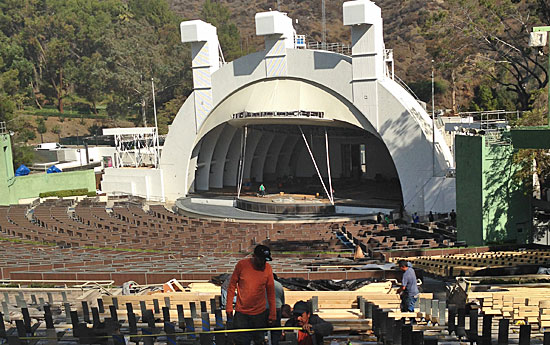
Alaskan yellow cedar benches are going in at the Bowl, replacing old ones that have seated millions.
Consider the lot of the lowly Hollywood Bowl benches.
Every summer, they bear silent witness to sublime symphonies, cool jazz and the musical stylings of some of the biggest names in pop. They brave the elements year ‘round, and when the amphitheatre is in full swing, get up close and personal with some 14,000 rear ends a night (some shielded with cushions, others not so much.)
Is it any wonder that eventually even the staunchest Bowl bench starts to crack under all the pressure?
But relief is on the way for the current crop of benches, which were installed at the dawn of the Reagan Administration and have hosted more than 18 million backsides in their time.
Mark Ladd, the Bowl’s assistant director of operations, calls the bench replacement “a once-in-a-career project.”
“It’s exciting to see it get done,” Ladd said. “If you take a look at some of the older wood, you’ll see it’s overdue.”
Underwritten by Prop. A park improvement dollars and other funds made available by Los Angeles County Supervisor Zev Yaroslavsky, the $1.6 million project is expected to wrap up in time for this year’s opening night on June 21. (Concertgoers for this year’s pre-season lease events like Black Sabbath, Billy Joel and Bruno Mars and Pharrell Williams will see a work in progress, with a mix of old and new benches available for seating.)
Beyond putting to rest the occasional splinter complaint, the new seats—which, like the earlier benches, are made of golden-hued Alaskan yellow cedar which will weather in time to a silvery gray—will be visually striking in their inaugural season.
And they’ll be widely used. While some music fans pony up for pricey box seats, the vast majority of Bowl patrons flock to the benches, where some weeknight concert tickets can be had for little as $1. (Another buck rents you a cushion for the night. For more on that and other tips for making the most of your Bowl experience, click here.)
The bench replacement project is part of a long list of improvements that have gone into the county-owned facility in recent years, including replacement of the legendary shell itself. New restrooms, park furniture to make it easier for more people to picnic at the site, “speed ramps” to whisk patrons to the Bowl’s upper levels, LED screens, a wine bar and a state-of-the-art sound system are among the upgrades in the just the past few seasons. (Industry professionals seem to be noticing; the Bowl recently nabbed its 10th straight Pollstar award as the nation’s best major outdoor concert venue.)
In addition to the new benches, this summer season will also be illuminated with new landscape lighting around the site, also funded by Yaroslavsky’s office. And the Los Angeles Philharmonic, which operates the Bowl under a lease agreement with the county, is replacing the stage floor, a maintenance procedure it undertakes every 10 years or so.
As construction workers buzzed around the site this week, assistant operations director Ladd noted that those venerable Bowl benches, installed back in 1981, may still not have reached the end of their long service to the people of Los Angeles County.
“We’re looking to re-use as much as we can,” Ladd said, pointing out that the wood can be re-milled and made available for repairs and future construction projects throughout the county parks system—an environmentally-friendly encore worthy of the Bowl itself.
Posted 3/5/14
The people’s art
February 27, 2014
From a rammed earth sculpture in the high desert to glimmering bronze leaves channeling the olive groves of yesteryear, the county’s civic art collection is as diverse as Los Angeles County itself.
And it’s growing fast.
In just the past four years, the program has added 58 new artworks and restorations to its collection. The new works join a vibrant array of earlier projects commissioned and managed by the Los Angeles County Arts Commission as part of the Civic Art Program, which requires that 1% of the design and construction costs on new county capital projects be set aside for art.
Since the Board of Supervisors approved the program in December, 2004, a total of 80 projects have been completed at L.A. County facilities. And more are on the way, including the first $1 million civic art endeavor, at the Martin Luther King, Jr. Medical Campus, as well as projects at the renovated Hall of Justice and the new San Fernando Valley Family Support Center.
Margaret Bruning, who directs the program, said the aim is to “create artworks and facilities that reflect who we are as a community and a culture, where we are now—and where we think we’re going.”
“We often say that civic art is about the art of the place…But it’s more than just art in the pure sense,” she said. “It’s about people and their experience of this place and of each other. And I think that’s the civic-mindedness that comes through in civic art.”
As the program’s 10th anniversary approaches, take a spin through the photo gallery below to appreciate some of the compelling, beautiful or just plain fun artwork that has been integrated into county facilities—from swimming pools and skate parks to libraries and fire stations—over the past decade.
Posted 2/26/14
As LACMA grows, economy lights up
January 23, 2014
There’s art that enriches the soul and there are investments that boost the bottom line. And then there’s the Los Angeles County Museum of Art, which has embarked on a “Transformation” campaign that—in addition to creating new galleries and installing epic works of art like “Urban Light” and “Levitated Mass”—generated more than $477 million in economic benefits for L.A. County, a new report finds.
The report by the Los Angeles County Economic Development Corporation, commissioned by the museum and being released today, studied visitor patterns and the direct and indirect impacts of building new destinations on the LACMA campus, ranging from the Broad Contemporary Art Museum and the Resnick Pavilion to Ray’s and Stark Bar.
Overall, the museum spent $269 million over nine years to complete the first two phases of the three-part initiative, with about $30 million coming from Los Angeles County and the rest from donors.
It was money well spent, the study found. In addition to generating economic output of more than $477 million, it supported 3,650 jobs—1,300 of them ongoing and not directly related to the construction itself—and contributed to an additional estimated $22 million in state and local taxes and $41.7 million in federal taxes.
The benefits don’t stop there, said Christine Cooper, the study’s lead author. “It’s going to keep on coming back,” she said, noting that researchers estimate that $255 million in continuing economic activity flows from the new-and-improved LACMA each year, plus state and local taxes of $11 million.
“LACMA’s Transformation demonstrates how public investment and private philanthropy can together create a larger overall benefit to Los Angeles County,” the report said. It noted that the county investment “will be repaid in tax revenues to the county within just a few years” because of all the resulting economic activity.
During the course of the campaign, museum attendance has more than doubled, reaching over 1.2 million visitors last year. And the museum’s visibility on the local, national and international scene has grown as well, with the arrival of LACMA director and CEO Michael Govan in 2006. Chris Burden’s much-photographed “Urban Light,” one of the artistic hallmarks of LACMA’s growth initiative, has become an instantly recognizable icon to passersby and museum-goers alike. And the slo-mo, 105-mile journey of the 340-ton boulder that plays the starring role in Michael Heizer’s “Levitated Mass” created a populist, communal sensation across the Southland and beyond.
The two phases of the initiative completed so far have “elevated the museum’s cultural standing to gain national and global recognition as a center of arts and entertainment,” the report said.
LACMA continues to draw the majority of its visitors from California, mostly from the Los Angeles region. However, the number of international visitors and those from other states grew from 11.5% in fiscal 2007 to 16% in fiscal 2013, the report said. “This shift in the origin of museum attendees is evidence of the growing international reputation of the museum and of the Los Angeles region and its global draw,” it found.
That’s economically significant, the report said, because visitors from outside the region tend to spend more when they visit—on gift shop purchases, food and drink, and other items. The benefit also goes beyond the museum itself; LACMA’s out-of-town visitors paid for accommodations, transportation, entertainment and meals around the area to the tune of $29.1 million in fiscal 2013—nearly three times as much as they spent in fiscal 2007.
The third phase of the “Transformation” initiative focuses on the east side of the LACMA campus. A proposed new signature building by Pritzker Prize-winning architect Peter Zumthor is in the planning phases.
The changes so far have had a remarkable impact, one that promises to endure, said Los Angeles County Supervisor Zev Yaroslavsky.
“Over the past seven years, LACMA has evolved into a thriving center of cultural activity,” Yaroslavsky said in a statement. “LACMA’s success is an example of a private/public partnership that will offer economic and educational benefits for years to come.”
Posted 1/23/14
An artful salute to veterans
December 12, 2013
As the county’s Bob Hope Patriotic Hall is formally rededicated this week after an extensive renovation, a trio of murals brought to life over the past 3½ years by acclaimed L.A. artist Kent Twitchell will share the spotlight with the array of dignitaries, veterans and military bands on hand to mark the building’s transformation.
Twitchell’s murals, which reimagine the original artworks by Helen Lundeberg that mysteriously vanished from the building’s lobby sometime in the 1970s, depict veterans of many generations in patriotic scenes. This video captures Twitchell’s work in progress last year.
Twitchell’s work, called “We the People, Out of Many, One,” consists of three large tableaux, each measuring 20 feet by 12 feet. It was commissioned by the Los Angeles County Arts Commission as part of the county’s Civic Art Program.
The Patriotic Hall setting represents an unusual venue for Twitchell: the great indoors. He is best known for his massive and much-celebrated outdoor works, including “Harbor Freeway Overture,” that have helped define the L.A. cityscape for decades. But some of his greatest exterior works have been lost over the years, including the six-story high “Ed Ruscha Monument,” which was painted over by work crews in 2006. As he started work on the Patriotic Hall project, Twitchell said that he welcomed the opportunity to create art inside, since the outdoors increasingly seemed like “enemy territory.”
Although the rededication event on Friday, November 8, is not open to the public, the building is already up and running as the new home of the county’s Department of Military and Veterans Affairs. The county’s Department of Mental Health also offers services to veterans in the building, which was originally dedicated in 1926. Other veterans service organizations are also expected to move in by the end of the year. Bob Hope Patriotic Hall, located at 1816 South Figueroa Street in downtown Los Angeles, has long been a familiar landmark to motorists traveling through the intersection of the 110 and 10 freeways.
Among those expected to take part Friday in the rededication is 103-year-old veteran Bea Cohen, believed to be the oldest living female veteran in California. Cohen, who served in the U.S. Army during World War II, remains an active volunteer for veterans’ causes.
The celebration of the building’s reopening after its $46 million renovation will be emceed by NBC4 weatherman Fritz Coleman. Also participating will be representatives of StoryCorps’ Military Voices Initiative, who will record the stories of veterans and their families at the site. Among those slated to record their stories: Kent Twitchell himself, who in addition to being a renowned muralist also is a Vietnam veteran.
Posted 11/6/13
LACMA redesign to respect tar pits
September 26, 2013
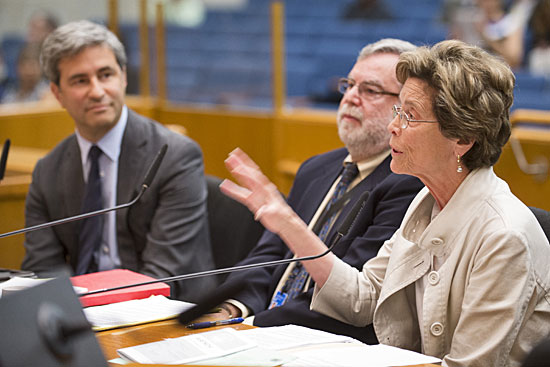
Jane Pisano of the Natural History Museum addresses supervisors, as LACMA's Michael Govan, far left, and James Gilson of NHM look on.
Leaders of the Los Angeles County Museum of Art and Natural History Museum are pledging to work together to make sure that a proposed new signature building on the LACMA campus doesn’t harm the landmark La Brea Tar Pits.
Preliminary plans for the new art gallery, to be designed by Pritzker Prize-winning architect Peter Zumthor, were unveiled this summer as part of LACMA’s “Presence of Past” exhibition, which showcased the architect’s concepts for transforming the museum campus.
The Swiss architect’s proposal calls for a largely transparent gallery—allowing passersby to view art through glass even without entering the museum—built in a curving shape reminiscent of the tar pits on the site.
But concerns about those tar pits quickly bubbled up after an early model and design were put on public display.
Officials of the Natural History Museum and its Page Museum, which oversees the Pleistocene era fossil-rich tar pits as an active scientific research site as well as a public attraction, were worried about the impact of the proposed LACMA construction.
On Tuesday, leaders of LACMA and the Natural History Museum came together to inform the Board of Supervisors that they are committed to working together to make sure the tar pits are protected.
“We can guarantee that there will not be a significant impact on the La Brea Tar Pits as we develop the plan,” Michael Govan, LACMA’s director and CEO, told the supervisors. He added that the design, now in its “earliest stages,” is meant not only to improve LACMA but also to create better access to the Page Museum and the tar pits that share the Hancock Park site, which he said would end up with an additional 1.2 acres of ground space. A cantilevered section of the design over the tar pit lake bed already is being altered in response to concerns, Govan said.
Jane Pisano, the Natural History Museum’s president and director, noted that LACMA’s plan is still “very preliminary and fluid, and if there is a negative impact on the tar pits, the design can and will be adjusted to protect them. This is something that Michael has said many times, and we take him at his word.”
However, she added, there are challenges ahead.
“Preliminary review of the plans for the building indicate that it would severely impact six of the nine tar pits in the park,” she said.
“So, early days, we know we have a lot of work to do. But we are assured that it is early days,” Pisano said. She said the early collaboration is essential to ensure that this “world-renowned destination” and unique scientific resource isn’t harmed.
“Ice Age fossils and micro fauna trapped in the tar below the surface provide invaluable information about life thousands of years ago, as well as possible clues for climate change and habitat in the future,” Pisano said.
Both parties said they are continuing to work with the county’s Chief Executive Office in the coming weeks to develop a memorandum of understanding to help them chart the course ahead. If the project is approved by LACMA’s board of trustees, the museum would undertake a two-year feasibility study. Construction would not begin until sometime after a new motion picture museum opens on the campus in 2017.
Govan said that the project presents LACMA with a unique opportunity to be a leader in reimagining how an encyclopedic museum can be structured.
“It has a plan that will be more accessible to the public than I think any that’s been designed anywhere in the world to date,” he said. “And that’s one of the exciting opportunities of a museum in a park.”
Doing nothing is not an option, he added, given the deteriorating state of the four buildings that would be replaced by the new structure.
Just bringing those buildings up to code would cost $317 million, he said. Early construction cost estimates for the new building range from $400 million to $450 million—costs that would be offset by significant energy savings from the building’s solar panels and by an increase in visitors to the museum, he said.
Supervisor Zev Yaroslavsky said that he was “not overly thrilled’ by the design at first, but has come to see it as a “stroke of genius.”
“This is a controversial plan architecturally. Any decent architectural plan is going to be controversial. If there’s no controversy, it isn’t worth the paper it’s written on.”
“Being able to build your project without doing any damage to the tar pits and the scientific research that continues to be done there is a no-brainer,” Yaroslavsky said. “There is room enough on that campus for both the tar pits and for the museum. And that’s the way it’s going to have to be.”
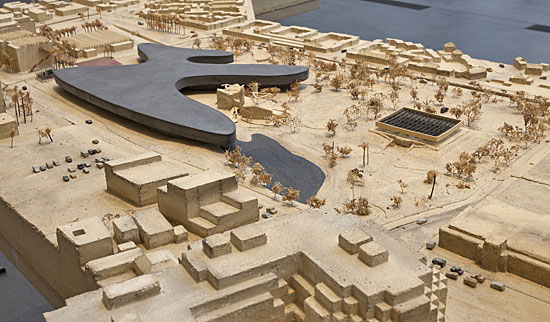
Architect Peter Zumthor's initial vision for LACMA shows a cantilever over tar pit lake bed. That element has since been altered. Photo/LACMA
Posted 9/25/13
No bouncing in the park
September 6, 2013
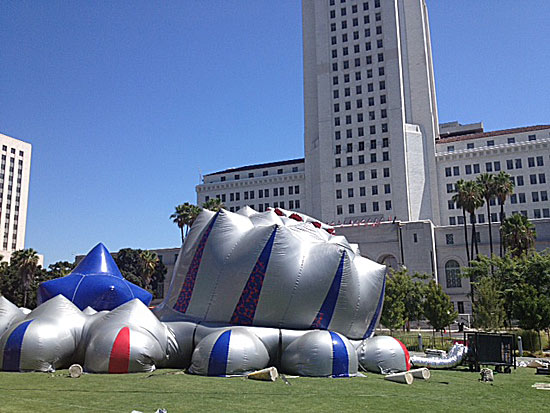
Exxopolis as it starts to rise in the Civic Center, creating a temporary, inflatable, walk-though world.
“It lives!” exclaimed Christine Breihan as air began to fill Exxopolis—the city-like, inflated art installation that opens to the public this Saturday in Grand Park.
Exxopolis arrived in a box truck Thursday morning, and Breihan and her confederates began setting up immediately, a bit behind schedule after a forklift had to be located at the last minute. Deflated, the exhibit only took up half of the truck, but after being rolled out and positioned, the grey, blue, green and red polyvinyl spanned 175 feet by 95 feet. And as it rose, the installation’s largest dome soared 23 feet into the air.
The fanciful, portable city is making its Los Angeles debut, with the public invited to stroll, free of charge, through its translucent, color-filled interiors over the course of the next two weekends. It is the brainchild of artist Alan Parkinson, whose Nottingham, England-based Architects of Air studio creates giant inflatables called “luminaria” and sends them out into the world on a mission to inspire wonder. Their work began more than two decades ago, growing out of a theatre project for audiences with disabilities. The fully accessible creations aim to attract the widest possible audiences; 500 of them have been displayed in 37 countries since 1992.
But before Exxopolis can work its magic, there’s plenty of advance work to get it off the ground.
Just ask Shanti Freed, the Exxopolis exhibition manager in charge of installing, managing and tearing down the structure after each day’s exhibition.
“There are a lot of floating variables,” Freed said. “It takes a good, long, steady day to set it up and make sure it is all laid out and ballasted correctly.”
Exxopolis requires 32,500 pounds of ballast just to hold it down. Concrete cones and drums are arranged like tent stakes along the perimeter and in gaps between the structure’s undulations. Inflating is the easy part; that only takes about 20 minutes.
Freed’s No. 1 consideration is making sure the 80 or so people who will be in the exhibit at any given time are safe. Staff from the Music Center, which manages Grand Park, will be trained to ensure guests follow rules, which include no running, jumping or sliding.
“The only thing it has in common with a bouncy castle is that it’s inflated,” Freed said of the artwork. “Anyone under the age of 16 must be with a parent; you have to be respectful of that space.”
Her biggest enemy is weather. Last year in Michigan, people were touring when tornado sirens blared. “It was the fastest evacuation I ever did,” Freed said. Trees were uprooted just 2 blocks away and, when Freed emerged from an underground storm shelter, three inches of rain had soaked everything.
Freed said L.A.’s heat shouldn’t pose any difficulties. While it may not be as cold as an office building, massive air conditioners pump air constantly, keeping the interior a few degrees cooler than outside.
The bubble shaped buildings, which are grey on the outside with patches of color where light enters and is reflected, are a striking temporary addition to the park’s green lawn across from City Hall. But things really get interesting inside.
“It’s like a kaleidoscope rainbow, but with no hard edges,” Freed said. “Everything is curved,”
Exxopolis’ L.A. visit comes as part of a U.S. tour. (Next stop: Shreveport, Louisiana.) It will be open to the public on the next two weekends, September 7 through September 8 and September 13 through September 15. People can tour it from 10 a.m. to 6 p.m. each day. The free exhibit has already generated a lot of interest, with advance reservations completely filling up. However, those reservations only comprise half of the possible slots, so walk-ups will be taken on a first come, first served basis. The wheelchair-accessible exhibit is open to all ages.
The experience even comes with a soundtrack, of sorts. The Music Center’s senior director for programming, Barbara Leonard, has arranged for 80 performances called “Random Acts of World Culture,” which will be staged at various places during the exhibition. Most will take place in a large dome called the Cupola, a cathedral-inspired space with plastic “stained glass” windows. Performances will range from individual artists to a septet, with musical styles that span the globe. It is the first time that live music has been integrated into one of the inflatable installations.
“I am very aware of the vision of Grand Park—‘the park for everyone,’ ” Leonard said. “We put the focus on 77 cultures that are a part of our city’s history.”
Leonard met Parkinson in 1994 at a conference, and toured several of his exhibits in other cities. Impressed, she tucked away the idea of bringing a luminarium to Los Angeles someday. When Grand Park opened, the opportunity presented itself. Thursday, she was giddy to see the structure take shape at last.
“Exxopolis is its own little city in my mind,” Leonard said. “We want to make sure the space and the performances have a harmony, have a beauty.”
Posted 9/6/13




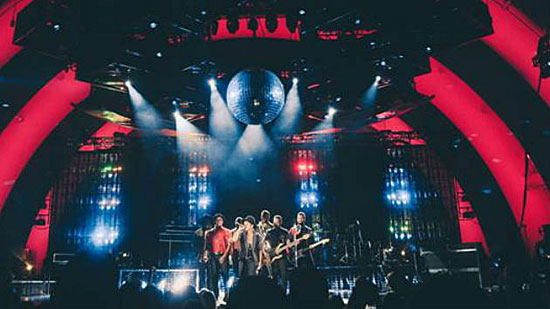
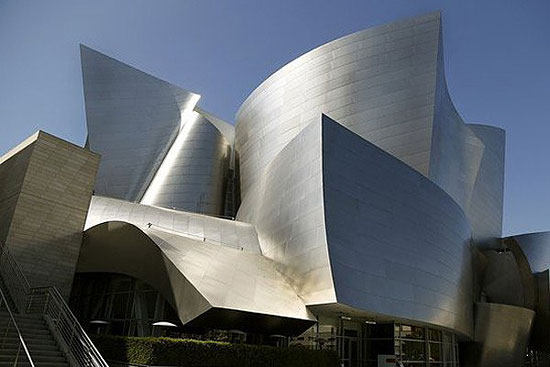

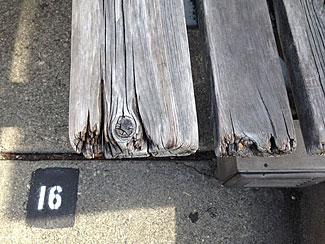
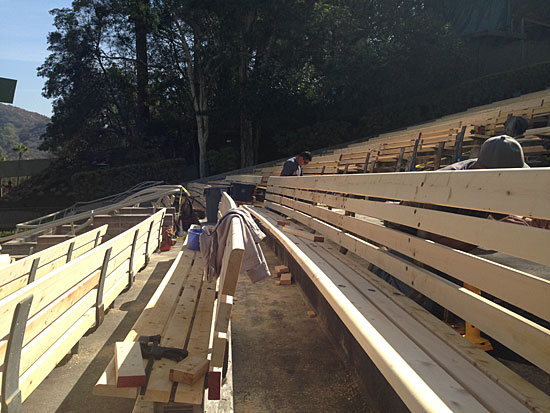
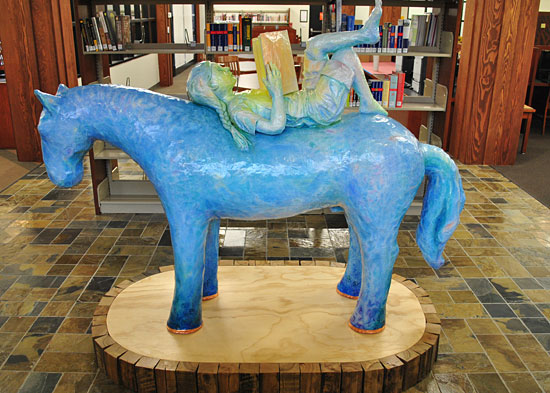






























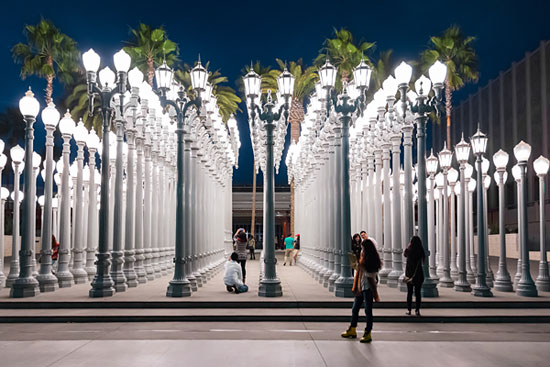
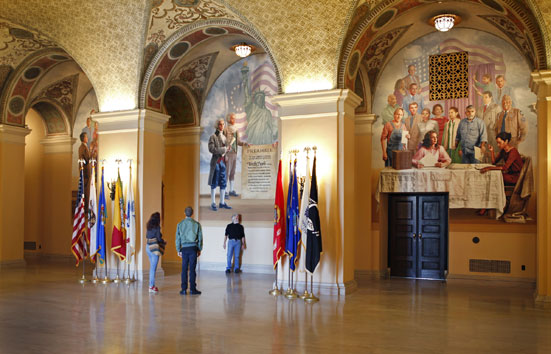
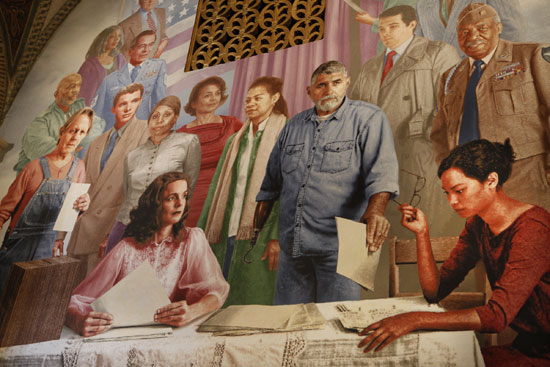
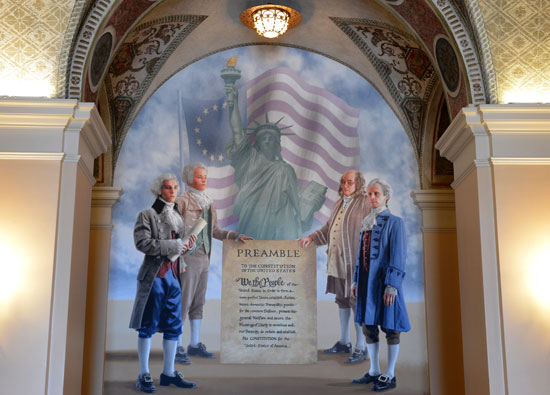
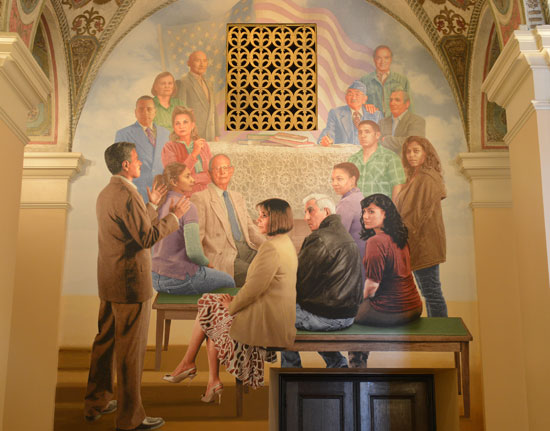
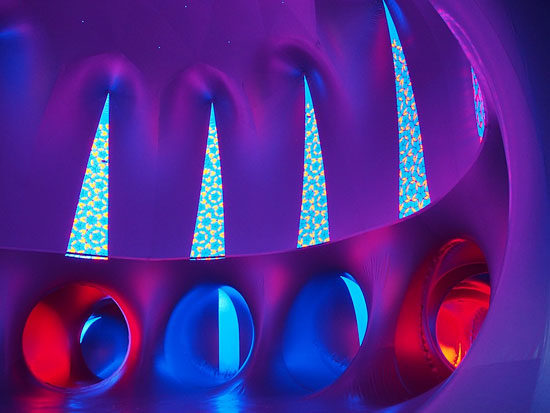









 405 bridge work causes a stink
405 bridge work causes a stink